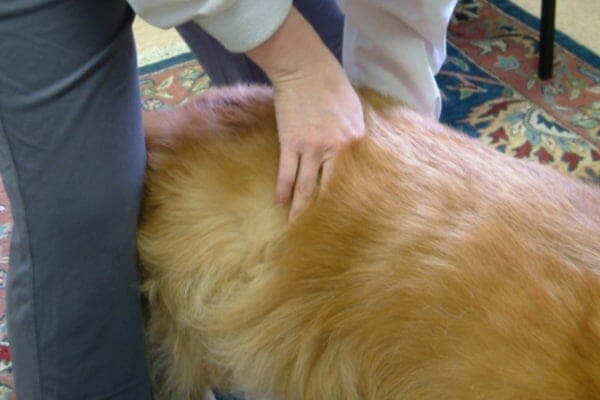As our furry companions age, they may start showing signs of wear and tear, with one common indicator being their spine visibly protruding under the skin. In this blog, we delve into the intricacies of an old dog spine showing – why it happens, when to be concerned, and how to best support our senior dogs through this stage of life.
Understanding the reasons behind an old dog spine showing can help pet owners provide the necessary care and comfort to their aging pets. Whether it’s due to muscle loss, weight changes, or underlying health issues, being aware of these factors is crucial in ensuring the well-being of our beloved four-legged friends.
Understanding Aging in Dogs
As dogs age, several changes occur in their bodies, including the spine. It is common for aging dogs to show signs of spinal issues, such as arthritis and degenerative disc disease, which can manifest as symptoms like difficulty in walking, stiffness, and pain. Understanding these age-related changes can help pet owners provide better care and support for their furry companions.
Common Spinal Conditions in Aging Dogs
Older dogs are prone to various spinal conditions that can impact their mobility and quality of life. These conditions may include:
- Arthritis: This degenerative joint disease commonly affects aging dogs and can lead to pain and stiffness in the spine.
- Intervertebral Disc Disease (IVDD): IVDD is a condition where the discs between the vertebrae degenerate, leading to compression of the spinal cord and nerves.
- Spondylosis: This is a condition where bony spurs form along the spine, causing pain and limiting movement.
Managing Spinal Health in Older Dogs
Proper care and management are crucial for maintaining the spinal health of aging dogs. Some tips to help support your senior dog’s spine include:
- Providing a balanced diet to maintain a healthy weight and support joint health.
- Regular exercise to keep muscles strong and joints flexible.
- Creating a comfortable environment with orthopedic bedding and ramps to reduce strain on the spine.

Signs and Symptoms of Aging in Dogs
As our furry companions age, various signs and symptoms may manifest, indicating the natural progression of time and potential health issues. Understanding these indicators can help pet owners provide appropriate care and support for their aging dogs.
Changes in Mobility
Older dogs may exhibit signs of reduced mobility, such as stiffness, trouble climbing stairs, or reluctance to engage in physical activities they once enjoyed. These symptoms could be attributed to conditions like arthritis, which commonly affect senior dogs.
It’s essential to observe any changes in your dog’s gait or movement patterns and consult with a veterinarian for proper assessment and management.
Behavioral Changes
Senior dogs may experience behavioral changes, including increased anxiety, confusion, or disorientation. Cognitive dysfunction syndrome (similar to dementia in humans) is a possible cause, leading to altered behavior patterns.
Providing mental stimulation, maintaining routines, and creating a safe environment can help alleviate some of these behavioral changes in aging dogs.
Changes in Coat and Skin
With age, dogs may develop changes in their coat and skin health. This can manifest as dryness, thinning of the coat, or the appearance of lumps and bumps on the skin. Regular grooming and skin checks are crucial to monitor any abnormalities.
Proper nutrition and supplements rich in essential fatty acids can support the skin and coat health of aging dogs.
Causes of Spinal Changes in Older Dogs
As dogs age, they are prone to various spinal changes that can affect their mobility and quality of life. These changes can be attributed to several factors:
1. Degenerative Disc Disease (DDD)
Degenerative Disc Disease is a common condition in older dogs where the intervertebral discs deteriorate over time, leading to pain and stiffness in the spine. This condition can be exacerbated in dogs exhibiting symptoms of old dog spine showing.
2. Osteoarthritis
Osteoarthritis, also known as arthritis, is a degenerative joint disease that can affect the spine of older dogs. It causes inflammation, pain, and stiffness in the joints, leading to difficulty in movement.
3. Spondylosis
Spondylosis is a condition characterized by the formation of bony spurs along the spine. These bony growths can cause pain and restrict the dog’s range of motion, especially in advanced stages.
Implications of a Visible Spine in Senior Dogs
As dogs age, it’s not uncommon for their spines to become more visible, especially in senior dogs. This can be due to a variety of reasons such as muscle loss, decreased mobility, or age-related conditions affecting the spine.
Possible Health Issues
When an old dog’s spine starts showing prominently, it could indicate underlying health issues such as arthritis, intervertebral disc disease, or osteoporosis. These conditions can cause discomfort and affect the dog’s quality of life.
In some cases, a visible spine may also be a sign of weight loss or malnutrition, which can further exacerbate existing health problems.
Importance of Regular Vet Check-ups
Regular veterinary check-ups are crucial for senior dogs, especially when changes in their physical appearance are noted. A vet can assess the dog’s overall health and recommend appropriate treatment or management strategies.
Early detection of spine-related issues can help in implementing interventions to improve the dog’s comfort and mobility.
Managing and Supporting Senior Dogs with Spinal Issues
As dogs age, they may develop spinal issues that can impact their mobility and overall quality of life. It is crucial for pet owners to understand how to manage and support senior dogs with spinal issues to ensure their well-being.
1. Recognizing the Signs
Older dogs experiencing spinal issues may show symptoms like stiffness, limping, difficulty standing up or climbing stairs, and decreased activity levels.
2. Consultation with a Veterinarian
If you notice any signs of spinal issues in your senior dog, it is essential to seek veterinarianary attention immediately
Frequently Asked Questions
- What causes an old dog’s spine to start showing?
- As dogs age, they may experience muscle loss and decreased fat deposits, which can result in their spine showing more prominently.
- Is it normal for an old dog’s spine to become more visible?
- Yes, it is common for older dogs to have their spine become more noticeable as they age due to changes in muscle mass and fat distribution.
- Should I be concerned if my old dog’s spine is showing?
- While some degree of spine visibility in older dogs is normal, it is advisable to consult with a veterinarian to rule out any underlying health issues causing excessive weight loss or muscle wasting.
- How can I help my old dog maintain a healthy weight and muscle mass to prevent his spine from showing prominently?
- Providing a balanced diet, regular exercise appropriate for your dog’s age and health condition, and veterinary check-ups can help in maintaining your old dog’s weight and muscle mass.
- Are there any medical conditions that can cause an old dog’s spine to show more than usual?
- Certain health issues like hyperthyroidism, malnutrition, cancer, or other metabolic disorders can contribute to extreme weight loss and muscle wasting in older dogs, leading to a more visible spine.
Final Thoughts
Exploring the intricacies of an old dog’s spine showing has shed light on the importance of understanding the aging process in our beloved pets. As our furry companions grow older, their spine health plays a crucial role in maintaining their quality of life. From recognizing the signs of spinal issues to implementing preventive measures, being proactive in caring for an old dog’s spine can significantly enhance their well-being.
Remember, regular exercise, proper nutrition, and routine check-ups are key factors in ensuring that your old dog’s spine stays strong and healthy. By staying informed and attentive to your pet’s needs, you can provide them with the support and love they deserve in their golden years.



